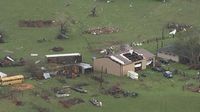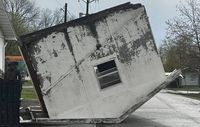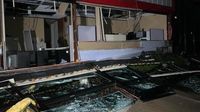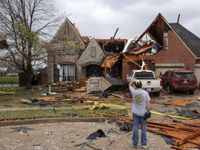Severe storms wreaked havoc across the South and Midwest on April 2, 2025, leading to multiple tornado warnings and causing significant destruction in several states. Arkansas, Missouri, and Tennessee were particularly hard hit, with reports of injuries, fatalities, and extensive damage to homes and infrastructure.
In Arkansas, Governor Sarah Huckabee Sanders declared a state of emergency as severe storms, including tornadoes, were expected to cause widespread damage. The governor allocated $250,000 from the Governor's Disaster Response and Recovery Fund to assist with recovery efforts. "Adverse circumstances may be brought to bear upon citizens and public properties in the State of Arkansas," the executive order stated, emphasizing the need for immediate action.
As the storms progressed, reports surfaced of tornadoes touching down in various regions. The sheriff of Poinsett County confirmed that tornadoes had struck, with one tornado spotted in Lake City and another crossing Highway 1 in Greenfield. Although damage to power lines and trees was reported, there were no immediate reports of injuries.
Meanwhile, in Tennessee, the aftermath of the storms was equally devastating. Photos and videos captured the destruction in Selmer, where emergency crews, including the Tennessee Highway Patrol, searched through wreckage for potential victims. The storms left a significant mark, with a viewer capturing a tornado on video early Wednesday evening.
In Missouri, tornado sirens sounded across several counties as an EF-1 tornado was confirmed to have swirled through southwest Missouri. The storm moved rapidly, with winds reaching up to 70 miles per hour. Reports indicated that several businesses in Nevada suffered damage, with roofs torn off and trees downed. The storm also resulted in power outages and train cars being knocked over.
As the day progressed, additional tornado warnings were issued in southeast Missouri, including areas like Potosi and Cape Girardeau. Governor Mike Kehoe activated the Missouri National Guard to assist in the response to the storms, which had already claimed lives earlier in March when a system spawned multiple tornadoes, resulting in 13 fatalities.
In Oklahoma, emergency crews assessed damage after severe storms swept through northeastern parts of the state. Owasso city officials reported that a possible tornado flipped semi-trailers at a local plant, with damage extending through Owasso, Broken Arrow, and Turley. Although no injuries were reported, the storms caused significant power outages affecting hundreds of customers.
Across the region, the National Weather Service issued dozens of tornado and severe thunderstorm warnings, indicating that the violent weather was a result of a combination of factors including daytime heating, unstable atmospheric conditions, and moisture from the Gulf of Mexico.
In total, three fatalities were confirmed due to the storms. The Tennessee Department of Health reported two weather-related deaths in McNairy and Obion counties, while one person was killed in southeast Missouri. The storms also caused injuries in Kentucky and Indiana, where debris from tornadoes struck various locations.
In Indiana, a warehouse in a suburb of Indianapolis partially collapsed, trapping workers inside. Emergency responders worked tirelessly to free those trapped, with reports indicating that at least two workers were injured in the incident. The storms also disrupted education, with several school districts in Indiana opting for remote learning days due to power outages.
As the storm system continued to move eastward, forecasters warned of potentially deadly flash flooding. Rainfall totals over the next several days could exceed a foot in some areas, raising concerns about significant flooding across the affected regions. The National Weather Service described the situation as a potential once-in-a-generation event, emphasizing the seriousness of the ongoing weather threats.
In summary, the violent storms that swept through the South and Midwest on April 2, 2025, left a trail of destruction and loss. With emergency services mobilized and recovery efforts underway, communities are beginning to assess the damage and prepare for the challenges ahead. As the threat of severe weather continues, officials urge residents to remain vigilant and heed warnings from local authorities.









